Oral Immunotherapy: Helping Babies Become Less Reactive to Allergenic Foods with David Stukus, MD
In this episode we're talking about:
- What OIT is, how it works and why Dr. Stukus has special nut flours in his office
- Whether babies under age 1 can start eating foods they are allergic to using OIT
- Concerns for use of OIT outside of a controlled, licensed medical facility
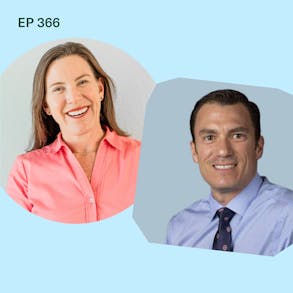
LISTEN TO THIS EPISODE
Episode Description
If your baby has a diagnosed food allergy, you might feel overwhelmed by the idea of food avoidance for the indefinite future. But Oral Immunotherapy (OIT) offers a promising alternative whereby a person can gradually learn to eat or tolerate increasingly larger amounts of the offending food protein working towards desensitization. In this episode pediatric allergist Dr. David Stukus explains what oral immunotherapy is, how it works and whether or not it’s a viable option for young children with food allergy.
About the Guest

- Dr. Stukus is board certified in allergy/immunology and pediatrics
- He’s the Director of the Food Allergy Treatment Center at Nationwide Children’s Hospital
- Dr. Stukus works with families of children with food allergies and does OIT in his clinic

Links from this Episode
- OIT from Food Allergy Research and Education (FARE): https://www.foodallergy.org/resources/oral-immunotherapy-oit-practice
- Dr. Dave bio from Nationwide Children’s https://www.nationwidechildrens.org/find-a-doctor/profiles/david-r-stukus
- OIT from AAAI with Dr. Stukus https://education.aaaai.org/2021AM_314
- Baby-Led Weaning with Katie Ferraro program with the 100 First Foods™ Daily Meal Plan, join here: https://babyledweaning.co/program
- Baby-Led Weaning for Beginners free online workshop with 100 First Foods™ list to all attendees, register here: https://babyledweaning.co/baby-led-weaning-for-beginners
Other episodes related to this topic:

Latest Episodes
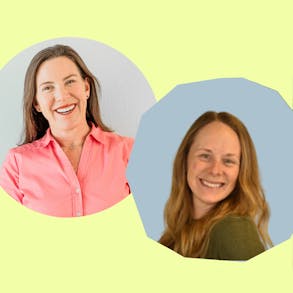
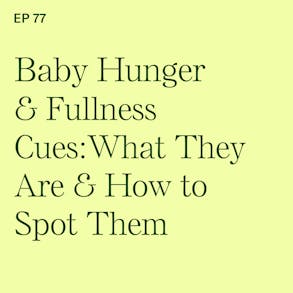
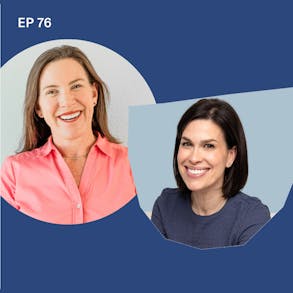
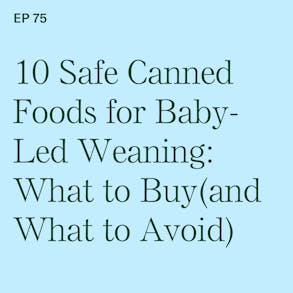

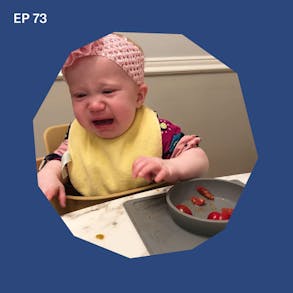
Katie Ferraro (0s):
Baby Ezra is my friend's son. He's six months plus three weeks. I'm making all of his hundred first Foods for baby-led weaning. So we're in week two. I just got done prepping Foods number six to 10 for him. So I. Wanna give you a rundown of the menu for week two if you need some new Foods inspo for your baby. So we do five new foods each week using my five step feeding framework. On Monday we do a new fruit. I made him apple So I did some cinnamon poached apple slices. Tuesday is the new vegetable of the week. So we did squash. I did some seasoned butternut squash sticks. Wednesday is the new starchy food. We're doing oatmeal this week. Thursday is the new protein we're doing. Pork So I made him a slow cooker caritas recipe. It's so good. Friday, new Allergenic Food of the Week and that's egg So.
Katie Ferraro (41s):
I made some fried egg strips for him to try. And if you want to follow the same 100 First Foods daily meal plan as Ezra is going through, you can. I've got the exact sequence of which new food to do on which day I provide you with a weekly menu, daily recipes, the shopping list for each week. I've literally done all of the work for you. This is all available inside of My program Baby-Led Weaning with Katie Ferraro. Again, that's a 100 First Foods daily meal plan. I don't wanna see you guys give up after you do those simple starter Foods like avocado, banana, and sweet potato. You gotta keep offering five new Foods each week. It's 20 Foods a month and in five short months, your baby will have eaten all of the 100 foods on the 100 First Foods list. Everything you need to get started is at babyledweaning.co/program.
Katie Ferraro (1m 25s):
I hope to see you there. babyledweaning.co/program. Common in tops on the list of work. Things I thought I was gonna loathe, but I ended up loving YouTube. We have a YouTube channel. It's about a year old. It's finally picking up steam and there are so many valuable videos over there if you want to see what starting solid foods looks like. I know I'm telling you about a YouTube channel while you're listening to a podcast, but if you have a chance, check it out. Our channel's Baby Led Weaning, it's literally the handle name. So original I know if you see something you like, subscribe, get notified each week when there's new videos. That's YouTube.com/babyledweaning.
David Stukus (2m 1s):
So OIT (Oral Immunotherapy) really is about the family taking proactive management of their child's or their own food allergy. OIT absolutely has to be done under the supervision of an experienced board certified allergist. The last thing we wanna do is give somebody a dose that's gonna cause a reaction.
Katie Ferraro (2m 16s):
Hey there. I'm Katie Ferraro, registered dietitian, college nutrition professor and mom of seven specializing in baby led weaning here on the Baby Led Weaning Made Easy podcast. I help you strip out all of the noise and nonsense about feeding, leaving you with the confidence and knowledge you need to give your baby a safe start to solid foods using baby led weaning If your baby has a diagnosed food allergy. You might feel overwhelmed by the idea of avoidance of that offending food for the indefinite future. But, Oral Immunotherapy or OIT offers a promising alternative whereby an Allergic person can gradually learn to eat or tolerate increasingly larger amounts of the the offending food protein working their way towards desensitization.
Katie Ferraro (3m 4s):
So right now in the United States, the only FDA approved treatment for food allergy is a peanut protein OIT product called Palforzia. But there are a small number of board certified allergists who use commercial food products to offer OIT as a service in their offices. And there are a lot of studies underway to evaluate how OIT works, And what the best practices are. But my guest today is Dr. David s Stukus. He's the director of the Food Allergy Treatment Center at Nationwide Children's Hospital. He's also a professor of clinical pediatrics at the Ohio State University College of Medicine and he's perhaps one of the world's best known pediatric allergists.
Katie Ferraro (3m 44s):
Dr. Stukus is very active on Instagram. He's @AllergyKidsDoc. And today Dr. Stukus is here to talk about Oral Immunotherapy or OIT and helping Babies become less reactive to allergenic foods.
David Stukus (3m 60s):
Hi. Thank you so much for having me. It's great to be back.
Katie Ferraro (4m 2s):
Okay. I know you said you just literally talked about OIT all morning long, so I'm excited to have this conversation. But before we get started, what's new at Nationwide Children's Hospital? What are any exciting work projects that you're working on or involved in right now that you can update us on?
David Stukus (4m 15s):
Oh yeah, thanks for asking. So it's just ongoing growth of our amazing food allergy treatment center. We're, you know, we're, we've seen, I think, oh my gosh, almost 3000 families since we opened our door a couple of years ago. And we've expanded our approaches to everything from diagnosis to food challenges. We have two psychologists on staff with us, which are really great resources for all the anxiety that goes along with that diagnosis. And then Oral Immunotherapy and we're involved in some clinical research trials. It is just, it's fun. It's a, it is a busy, fun place with lots of positive energy.
Katie Ferraro (4m 47s):
Totally biased here, but tell me about the dietitians on your team and how amazing they are.
David Stukus (4m 52s):
Aha. So we don't have, that's my, that's my next step. We, I don't have anybody on site which bothers me for budgetary reasons, but we do have folks that we can readily refer to in our
Katie Ferraro (5m 1s):
Wait time out. There's two psychologists and no dietitian.?
David Stukus (5m 5s):
Oh yeah, it's, oh, we're working on, okay.
Katie Ferraro (5m 7s):
Okay. I'll, I'll continue to be an advocate for the role of the registered dietitian, dietitian in pediatric food allergy treatment. But today, we wanted to talk about Oral Immunotherapy or OIT, which for people with food allergy and parents of kids with food allergy, it certainly sounds more appealing than like just avoid that allergenic food indefinitely. So what is OIT, how does it work? And then also, if you don't mind adding in like does it work for babies? 'cause our, our audience is primarily parents of Babies who are six to 12 months of age, some of whom do have diagnosed food allergies.
David Stukus (5m 36s):
Great place to start. One thing we spend a lot of time talking to every family who's interested in it or we bring it up to them, is really understanding exactly what It is, what it entails, and why we're doing it. When OIT was first started to be investigated, you know, over a decade ago, the reason why is because there are people with food allergy that are exquisitely sensitive to very small amounts like trace amounts. The vast majority of people are not, but there are those that are, and OIT is a way to reliably give them small amounts of their food allergen, increasing it over time on a daily consistent basis, which can sort of reset the immune system and increase the threshold amount they need to eat to cause a severe allergic reaction. It is not a cure for the vast majority of people with food allergy.
David Stukus (6m 19s):
We also wanna make sure we clarify the diagnosis. So it started out as being a treatment option to help protect people from accidentally taking a bite of something and hopefully not causing a severe reaction. But now it's been sort of expanded to, you know, I've seen families that their children aren't even actually allergic. They just had a, a false positive on testing when they were told that they need OIT in their life. Nobody needs OIT from a medical standpoint, But, it can provide a very proactive way to sort of manage food allergy and sort of provide that peace of mind. We can get into some of the details, but you know, I, I just kind of wanna start there of like just really understanding why am I doing this? Is my child actually allergic in the first place before you even think about it?
Katie Ferraro (6m 57s):
And I appreciate that history because I think we did used to hear it historically. It was like, oh this is a preventative measure, but now it seems to be kind of more curative and like, I'd just like to get your vibe on it because also I know things differ the way we do things in the United States with some other countries. Is OIT something that has been going on for a long time as a treatment modality or whatever it may be in Europe, but is new here? Are we kind of on the cutting edge here? How do we compare to the world with food allergy treatment with OIT stuff?
David Stukus (7m 24s):
You know, it does vary based upon location. I think that, you know, it's been used in private practice allergy offices in the United States for over a decade. We've learned a lot from the way they've been doing it. I think it's important to note that there's only one FDA approved OIT product that's for peanut. It's not a medicine, there's nothing magical about it, it's just peanut flour that's measured out very carefully. But a lot of folks have been just using regular food to help desensitize. There are other approaches as well, you know, so Oral Immunotherapy is eating it and swallowing it. There's drops under the tongue. So sublingual Immunotherapy for Foods, which are much more advanced in regards to other countries compared to the United States. We're starting to kind of catch up from a research standpoint and putting that into practice. But yeah, I mean it's been around for a while and, and we've learned a lot about it.
Katie Ferraro (8m 7s):
I'm just curious about your thoughts. I know you've always been like very food first. I love interviewing you. We talk about the benefits of introducing the foods to babies, that they don't need to buy fancy expensive supplement programs to get exposure to these food proteins. But I can see OIT gaining in popularity and going the direction of like drug companies being like, oh let's medicalize all of these food proteins when it's like, shouldn't we just be using the food? So what do you guys do in your clinic? Do you do food-based introductions or are you doing some of these like titrated smaller non-food medical products? I know there's, I guess, three different ways to introduce the protein. What do you guys prefer? Just from a practice standpoint or just your, you know, personal preference.
David Stukus (8m 42s):
Yeah, one thing I, I forgot to mention, and I think is the most important part of this whole conversation is OIT absolutely has to be done under the supervision of an experienced board certified allergist. There's a lot of math involved. The last thing we wanna do is give somebody somebody a dose that's gonna cause a reaction. But, so here, let's walk through sort of some of the details I guess. So OIT really is about the family taking proactive management of their child's or their own food allergy. This involves daily ingestion of specific amounts of that food protein, which has gradually increased every couple of weeks until we reach a maintenance dose. Consistency is the key because reactions can occur. So if you take somebody with a known food allergy and you give them the food they're allergic to, you could cause an allergic reaction.
David Stukus (9m 23s):
Now we try to minimize that as much as possible by being consistent with the dosing. Have a full stomach when you take it, no intense exercise for about two hours after the daily dose 'cause that can change the body's response to that food protein. And then really, you know, good communication with the supervising allergist. And then those doses are titrated very carefully every couple of weeks, we often have them come into the office for the next dose to make sure they tolerate it. Until you reach this predetermined maintenance dose while you're receiving this daily treatment and up to the maintenance, what it does is it helps kind of desensitize the immune system. If you stop treatment, you go back to being allergic. So that's why It is not curative. But while you're on the treatment, some people can start to incorporate more of that food into their diet, but you can have inconsistent dosing.
David Stukus (10m 4s):
So a lot of teenagers kind of fight back and they're tired of taking their, their dose every day. And, and non-adherence is a problem for toddlers and younger children. Sometimes it's more the taste aversion that we deal with, but it's, It is very important for every family to really understand what this entails and it's them, you know, taking over management essentially on a daily basis. This isn't like you give a little bit here and a little bit there. It really is very measured out and very precise and we just use food. So we use different food products and we know dose equivalents for, you know, this is, we're talking like milligram doses of protein that we're giving. For instance, you know, one peanut kernel contains roughly 300 milligrams of protein. There are some of our patients that we start at one milligram for their dose So, you know, that small of a dose.
David Stukus (10m 45s):
Others we start a little bit higher based upon their threshold and history and things like that. And then you have to measure it out. But real food seems to work out best, especially when you can mix it into,
Katie Ferraro (10m 54s):
You know, who's really good at measuring milligrams of peanut protein or dietitian. So in the future, if you didn't wanna do the math, that's kind of our thing. But I love the idea that you guys using real food and I do appreciate that about you and your work, that you'd really do prioritize food first. Curious if families graduate to being able to do OIT at home or is this something you always have to do in a medical facility? Like when's it over?
David Stukus (11m 14s):
Yeah, well essentially never. So we're, we're still learning like what does this mean? But when families start OIT, they have to be prepared. This is years long therapy. It's not like you've reached 12 months and you're done. This is consistent dosing. Now I think we're gonna learn over time that we can probably alter the dosing to, you know, every other day once every few days or or things like that. And It is probably bridging the gap until we actually get better therapies that don't carry the risk of causing a reaction with every dose. And you can still off of that protection, but I want people to be prepared for like, if we're doing this, we're committing to let's do this for years and years and years at least until the next good thing comes along. And I think there's some promising research in that room as well.
Katie Ferraro (11m 50s):
Hey, we're gonna take a quick break, but I'll be right back.
Katie Ferraro (12m 45s):
And you mentioned that the FDA approval for peanut only is, are you guys in your clinic? Do you do OIT with foods for like shellfish or is it just certain food allergies or all of the big nine Allergenic Foods can be treated with OIT?
David Stukus (12m 58s):
Yeah, we're happy to offer it for any food, but in general it tends to come down to peanuts, tree nuts and sesame. And you know, we're hesitant to offer milk and egg Oral Immunotherapy to very young children because the majority of them outgrow it on their own. And the last thing I wanna do is, you know, start something on this path where they think they need this treatment every day for years and years when they may just go away in a year or two. So it's much less likely there certainly is a role for it for older children who have persistent milk and egg allergy. But yeah, it tends to focus more on peanuts, tree nuts and sesame because sesame now especially is much harder to avoid because when they changed the, the labeling laws in the United States in January, more companies actually started adding sesame intentionally to their products as a workaround.
David Stukus (13m 38s):
They said, well we can't guarantee our facilities clean, so we're just gonna add it in. So now you know, these baked goods that previously didn't have sesame now contains sesame flower, which is really problematic for somebody who was eating them before without any issues. So a lot of families who have children with sesame allergy, that's what we're doing and we're trying to desensitize with the goal of like, let's get to the point where they can eat these things and not have a reaction.
Katie Ferraro (13m 58s):
So you mentioned there's the food-based introduction, that there's the sublingual. Is there a patch as well and do you guys do any of that or how does that work?
David Stukus (14m 4s):
Well that one's not available yet. So yes, the, the peanut patch or, or epicutaneous Immunotherapy involves, you know, microgram dosing on the skin and you leave it on the skin every day. And over time it desensitizes the immune system to also increase that threshold amount that you need to cause a reaction. The data looked great when the company went to the FDA, oh my gosh, almost two years ago. I think the FDA said we want the sticky part of the patch to be stickier. So we're actually gonna be one of the sites that's gonna be involved in the trial to demonstrate that it stays on the back as long as
Katie Ferraro (14m 34s):
Chief stickiness officer. I love it.
David Stukus (14m 35s):
Yeah, we're a stickiness officer. So, but yeah, the data looked really good. The side effects are much less compared to ingestion of it. And it's interesting. So when you, when you eat it and swallow it, it increases the risk of causing an allergic reaction, including anaphylaxis. So families need to know, like you, you're not getting rid of your epinephrine. This isn't something you can just kind of do, do as, as you see fit It is you need to monitor and be careful with that. Whereas sublingual Immunotherapy has less risk for those types of severe side effects. And then with the patch on the skin, the that risk goes down even more. It's gonna be a nice option whenever it's available.
Katie Ferraro (15m 6s):
One of the things that kind of inspired me to reach out to you and say can we talk about this on the podcast was 'cause I was interviewing another mom for a different type of episode. She works in mental health and we're talking about anxiety management for parents starting solid Foods she just mentioned as an aside and she's Canadian. She had recently done OIT for peanut allergy with her child. And you know, we always kind of compare and despair when you look at the Canadian health system, like, you know, they're 15 month long maternity leaves and like, I mean I just thought I was like so jealous of Canadians And, what they have access to in some regards. But she said it was not something that was covered by their health insurance program. She had to pay out of pocket. So for American families, is OIT covered or is it expensive? How does that work?
David Stukus (15m 44s):
Yes and no. It, you know, some practices have different, you know, ways that they go about it. I work in academic settings, so we absorb a lot of costs associated with these, but typically the cost entails just buying the food. And we do have, you know, special types of flowers and things like that that have specifics that make it easier to put into a solution for starting at very low doses. Sometimes we need to have scales because we're measuring out very precise amounts on the milligram range and that's kind of it. Otherwise what gets billed to insurance is when you come into the office for the up dosing visits every couple of weeks. But most of those are really just, you know, they, they should be covered about insurance and the special codes that we can use that are accepted by that. So that all should be figured out for the most part, at least in the United States.
Katie Ferraro (16m 22s):
Can I ask you about the terms desensitization versus tolerance? What's the difference between those terms and are you aiming for one or the other With OIT? You mentioned this is kind of an ongoing thing, so it might be a question you can't answer. I'm not sure.
David Stukus (16m 35s):
Oh, no, no, no. This is, that's a great question and we absolutely should talk about that. So the terminology matters and I actually, you, you bring a flashback, oh my gosh, this is pre pandemic. I was asked to give a talk on this at a national meeting. I spent 30 minutes just walk talking about terminology and it took me a while to get used to it 'cause it like these are are concepts we weren't quite used to discussing. Okay, so desensitization, we can pretty much desensitize anybody to anything. So if you have a true antibiotic allergy and you're in the hospital and you need that antibiotic to treat your infection, we can desensitize you. We give you really small amounts, we build it up, you know, over time until we can tolerate it. Desensitization means as long as you're receiving that allergen on a consistent basis, you will not have an Allergic reaction to it.
David Stukus (17m 16s):
Once you stop that treatment, you revert back to being allergic. So It is not curative. So with OIT, while you're receiving that daily dose on a consistent basis for years and years and years, you're desensitized, which means that you often can't freely eat it. Some people can But, it should protect you from having reactions to swollen eyes. Now tolerance is you're just not Allergic to it. So it means you can get exposed whenever you want, however much you want. It doesn't matter. And, what we're trying to do with OIT and some people and the data show, if you start it younger, like in Babies at 12 to 24 months, there's a higher percentage in that age group that may develop sustained unresponsiveness. Meaning you treat with OIT for a period of time, one year, two years, three years, you stop treatment, you wait, say three months, four months without eating that food.
David Stukus (18m 1s):
You go to eat it again and no reaction occurs. So that's, that's the goal here, right? That's essentially a cure for this. But you know, it, it's not like everybody can achieve that. That's not a realistic expectation of this treatment. Some can and we're hoping that if we started a little bit earlier that maybe we can achieve that in a higher percentage of people compared older.
Katie Ferraro (18m 18s):
Can you talk a little bit more about that infant population? Are you working with Babies between six and 12 months of age? And any insights that you can share about OIT for them versus maybe an older pediatric population?
David Stukus (18m 29s):
Yeah, so six to 12 months is a little bit young. Typically we start, you know, thinking about this around 12 months. But it depends on when they present. So typically we, you know, we don't get patients until they start eating food. So food allergy reactions can occur in infants. There's a misconception that infants have more severe reactions the first time and that's actually False it's the opposite. you know, most of the time babies, when they have a food allergy reaction, they get some hives and they may throw up one time, but it's, it's very unusual for like their airway to, to swell or have difficulty breathing or or severe anaphylaxis. It certainly can occur, but that's not the expectation. So when this, when that history develops, we evaluate and if we determine their food allergy, now we're having conversations of, well do you want to just avoid and repeat testing in a year and see if they outgrow it or do you wanna be more proactive and try to start OIT with this possibility that, you know, we can desensitize and get it in a diet in some realm and things like that.
David Stukus (19m 19s):
So the conversation's changed.
Katie Ferraro (19m 19s):
Hey, we're gonna take a quick break, but I'll be right back And for families that have children with food allergies, maybe they're just learning about considering OIT, where should they start researching as to whether or not this might be a plausible approach for them to manage their family's food allergy?
David Stukus (20m 42s):
Yeah, so as you know, I spend a lot of time on social media as a medical professional and if you want to find some really bad, bad outdated information, go to Instagram on Instagram or Twitter. So please be very, very careful. Other people are sharing stories as with anything on Instagram, like people are sharing the best sides of themselves and you're not getting all the details. So I always recommend starting with one's own personal doctor or allergist or go to a vetted professional or advocacy organization. So we have the American Academy and American College of Allergy, asthma and Immunology. There's wonderful patient advocacy organizations out there. Kids with food allergies, allergy and Asthma Foundation in America, among others.
David Stukus (21m 24s):
So. I recommend starting there because they have medical and scientific councils and advisory boards that vet the information before they even post on their website.
Katie Ferraro (21m 31s):
Well I so appreciate you always your willingness. I know you're super busy, but to come on, explain these topics and be really confusing to parents. The first time you came on the podcast was two and a half years ago at this point. So just curious, how have things changed in the last two or three years with regards to OIT and how you guys have been using it, and then where do you think it's going in the next two to three or four or five years?
David Stukus (21m 51s):
Everything's changed since we last spoke. Just our understanding of the pathophysiology and, and different types of food allergy and threshold doses and the way we can truly individualize management. It's all completely different and it's gonna change a year from now. So when I have families come in for their annual follow up, I, I'm always excited to see them because our conversation is changing. you know, we're gonna have a a device soon where you can spray epinephrine in the nose and not have to use the autoinjector that's gonna be available in the next year. Hopefully there's another company looking at strips under the tongue for epinephrine, for treatment of anaphylaxis. And then with OIT it's just more and more places are using it. But I think as it expands, that's where we have really have to be cautious about why are we doing it? Are we choosing the optimal patient?
David Stukus (22m 31s):
Are we putting somebody on OIT that isn't allergic in the first place so it's gonna outgrow their allergy another year? And that's where I see the danger of it. Now some families may not care and they just say, I don't care as long as you know, I'm treating them and I don't have to worry about it. And that's fine, but that's where shared decision making comes into play and I think that's a really important part of it.
Katie Ferraro (22m 47s):
Thank you so much for talking about OIT and kind of introducing us to this topic. If our audience wants to learn more about the work that you do at OIT in general, where do you suggest that they start researching?
David Stukus (22m 56s):
We have a great website, so you can just look at Nationwide Children's Hospital and you can try, you know, food Allergy Treatment Center. And then if anybody's interested, you can find me mostly on Instagram these days. Not in that place, formally known as Twitter, but I'm @AllergyKidsDoc,
Katie Ferraro (23m 10s):
Thank you so much, Dr. Stukus.
David Stukus (23m 12s):
Thank you.
Katie Ferraro (23m 12s):
Well, I hope you guys enjoyed that interview with Dr. Stukus. I always appreciate the opportunity to chat with him and pick his brain. He does not mince words. I love that. He cuts right to the chase, tells you about the science. He's got a mix of research and that practitioner expertise sprinkled in. I'm gonna share more of Dr. Stukus resources on the Shownotes for this episode, which you can find at BLW podcast.com/36 6. A special thank you to our partners at AirWave Media. If you guys like podcasts that feature food and science and using your brain, then AirWave Media has some great podcasts for you to listen to. We are online at BLW podcast.com and thank you so much for listening.
Katie Ferraro (23m 57s):
I'll see you next time If you're interested in doing baby-led weaning, but you're not exactly sure, like what does that mean? What does it look like? Where do I start? My online program called babyled Weaning with Katie Ferraro has everything you need to give your baby a safe start to solid Foods and get them to eat over a hundred Foods before they turn one, whether you're terrified of choking or maybe you've started but you feel like you're feeding your baby the same Foods over and over 'cause you don't know what to feed next or you're looking for guidance on how to prepare Foods safely for your baby's age and stage. My program has exactly what you need. There's five hours of concise self-paced video training. You can knock this thing out during nap time this week. You also get access to my hundred First Foods content library so you can see and learn exactly how to prep all of the a hundred Foods as well as my original a hundred days meal plan.
Katie Ferraro (24m 41s):
I've been refining this program for the last seven years. Just today, a mom wrote to me and told me that the a hundred days meal plan has been a game changer for her busy lifestyle. When you join the program, you also get access to over a hundred phase two combination food recipes. So you're gonna try out the trickier textures, push your baby's palate. And what's cool about these recipes is your whole family will enjoy them. So everything you need to give your baby a safe start to solid Foods is inside of the program. It's created by me, a registered dietitian who specializes in infant feeding. If you're tired of hunting and pecking around the internet trying to piece this stuff together on your own, I put it all in one convenient place for you. I invite you to check out the baby led weaning with Katie Ferraro program that's at baby led weaning dot co.
Katie Ferraro (25m 21s):
Again, that website is baby led weaning dot co and click on program to learn more.
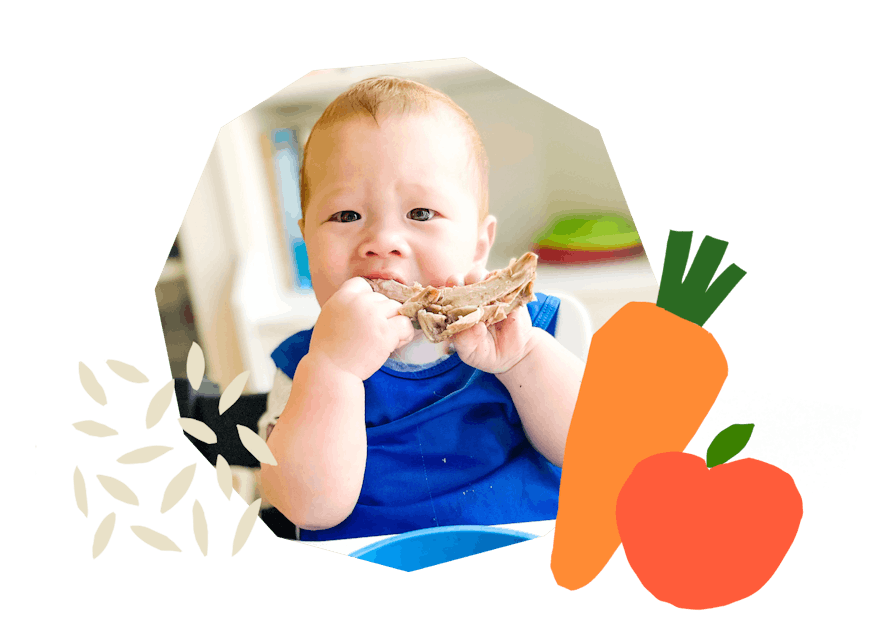
The Program Baby-Led Weaning with Katie Ferraro
A step-by-step digital program for starting solid foods safely and navigating the original 100 FIRST FOODS™ meal plan with baby-led weaning.
 EXPERT-LED, PROVEN APPROACH TO EATING REAL FOOD
EXPERT-LED, PROVEN APPROACH TO EATING REAL FOOD CONCISE VIDEO TRAININGS TO MASTER BABY-LED WEANING
CONCISE VIDEO TRAININGS TO MASTER BABY-LED WEANING 100 FIRST FOODS DAILY MEAL PLAN WITH FOOD PREP VIDEOS
100 FIRST FOODS DAILY MEAL PLAN WITH FOOD PREP VIDEOS
Baby-Led Weaning for Beginners Free Workshop
Is your baby ready to start solid foods, but you’re not sure where to start? Get ready to give your baby a solid foundation to a lifetime of loving real food…even if you’re feeling overwhelmed or confused about this next stage of infant feeding.
Get baby-led weaning recipes and tips delivered to your email inbox.

